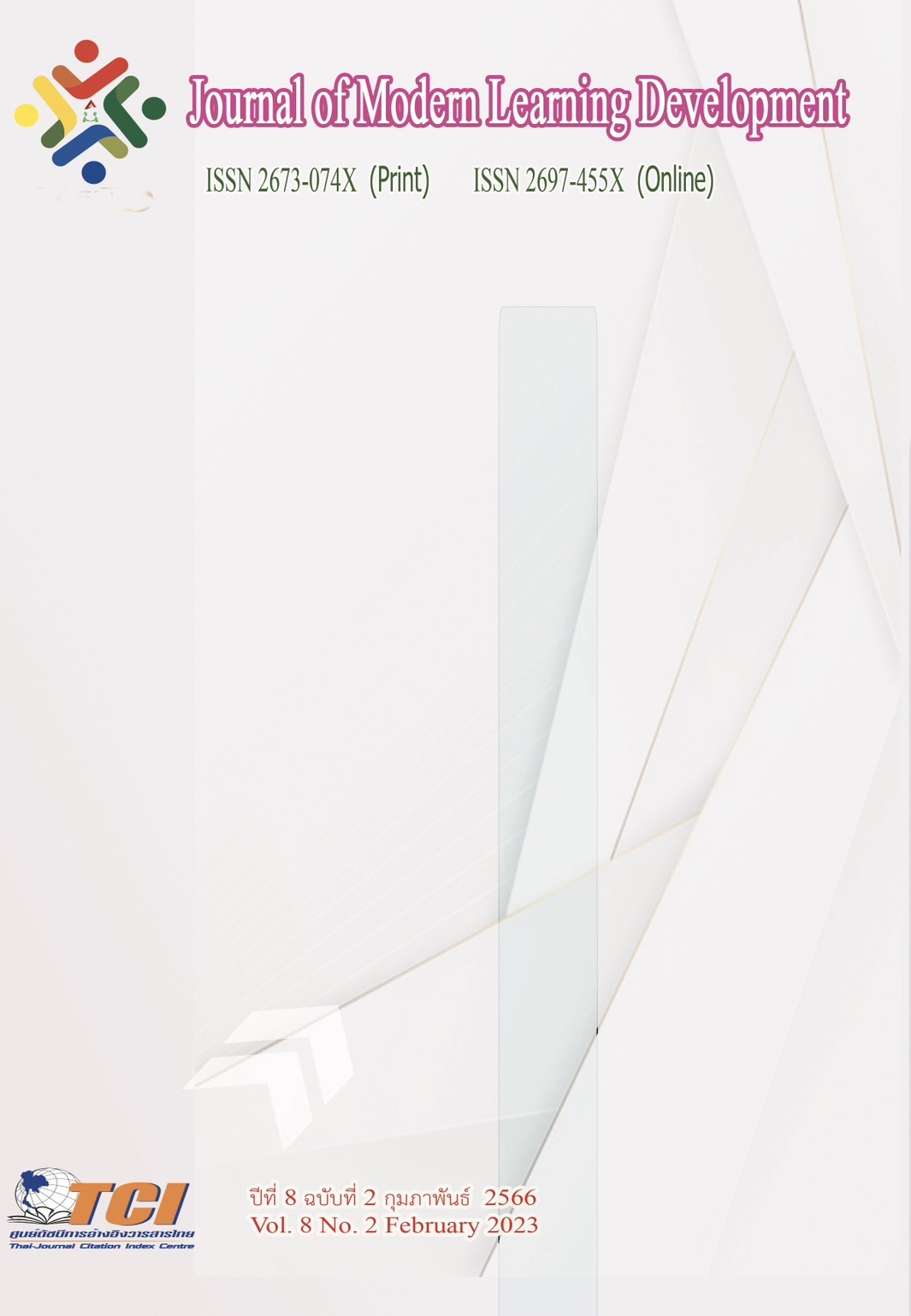The Clothes Buying Behavior through Online Platforms and the Marketing Mix Factors of the Decision Making in Purchasing Clothes through Online Platforms
Main Article Content
Abstract
The objectives of this research were to study 1) the clothes buying behavior of online consumers through online platforms, 2) the marketing mix factors of the decision making in purchasing clothes through online platforms, and 3) comparison of opinion levels on the marketing mix factors of the decision making in purchasing clothes through online platforms, that classified by online consumer demographics. The sample group were 400 respondents who buy clothes through online platforms, that collecled data by probabilistic random sampling method. The tool used to collect data were the questionnaires, that had Cronbach's alpha at 0.94. The statistics used for data analysis include percentage, mean, standard deviation, t-test, and One-way ANOVA.
The following were the results:
1. The buying behavior of online consumers through online platforms found the most of the respondents liked the simple clothing and style. The clothes types were trousers and t-shirts. They purchased through Instagram because the convenience of ordering. The frequency of buying clothes through online platforms was 2 times per month, 2 pieces each time, amounting more than 600 baht. Most of the respondents decided to buy clothes because the real reviewers.
2. The marketing mix factors of the decision making in purchasing clothes through online platforms found that; the respondents gave the highest priority in 7 aspests which produce, price, place, promotion, people, process, physical evidence, productivity and quality.
3. The respondents with the different of gender and age had different of the marketing mix factors in the decision to buy clothes through online platforms. The different of gender and age had different of the marketing mix factors in the decision to buy clothes through online platforms. The different of education level, occupation and monthly income had not different of the marketing mix factors in the decision to buy clothes through online platforms.
Article Details
References
กนกวรรณ คชอาจ. (2564). แบบจำลองธุรกิจแคนวาสจำหน่ายเสื้อผ้าแฟชั่นสตรีผ่านการพาณิชย์อิเล็กทรอนิกส์ของกลุ่มเจนเนอเรชันวายร้านลาน่าสโตร์. รายงานการศึกษาอิสระปริญญาบริหารธุรกิจ.มหาบัณฑิต. วิทยาลัยบัณฑิตศึกษาการจัดการ: มหาวิทยาลัยขอนแก่น.
กรมส่งเสริมการค้าระหว่างประเทศ. (2563). ธุรกิจแฟชั่นออนไลน์เติบโตและขับเคลื่อนโดยการดึงดูดผู้บริโภคกลุ่มใหม่ได้สำเร็จ. ออนไลน์. สืบค้นเมื่อ 25 กุมภาพันธ์ 2565. แหล่งที่มา: https://www.ditp.go.th/
ditp_web61/article_sub_view.php?filename=contents_attach/623154/623154.pdf&title=623154&cate=413&d=0
กัลยา วานิชย์บัญชา. (2560). การใช้ SPSS for Windows ในการวิเคราะห์ข้อมูล. พิมพ์ครั้งที่ 29. กรุงเทพมหานคร: สามลดา.
จิราพร ระโหฐาน และประวีณา สุขเกษม. (2560). ปัจจัยที่ส่งผลต่อพฤติกรรมผู้บริโภคในการเลือกซื้อเสื้อผ้าสุภาพบุรุษผ่านร้านค้าออนไลน์ในจังหวัดชลบุรี. วารสารวิชาการศรีปทุม ชลบุรี. 13 (4), 193-200
เจติยา ทองนวล (2560). แนวทางการสร้างแรงจูงใจในการตัดสินใจซื้อเสื้อผ้ามือสองออนไลน์ร้าน Cool Monkey ในเขตเทศบาลนครขอนแก่น. รายงานการศึกษาอิสระปริญญาบริหารธุรกิจ.มหาบัณฑิต. วิทยาลัยบัณฑิตศึกษาการจัดการ: มหาวิทยาลัยขอนแก่น.
ณัฐพล ใยไพโรจน์. (2563). Digital Marketing Concept & Case Study ฉบับรับมือ New Normal หลัง COVID-19. พิมพ์ครั้งที่ 7. นนทบุรี: ไอดีซี.
ทัศนา ประวิเศษ และธนาลัย สุคนธ์พันธุ์. (2563). TRY IT ON: แอปพลิเคชันห้องลองเสื้อผ้าออนไลน์ผ่านโทรศัพท์มือถือ. วารสารวิชาการวิทยาศาสตร์และเทคโนโลยี มหาวิทยาลัยราชภัฏสงขลา, 1 (2),
-67.
ธานินทร์ ศิลป์จารุ. (2560). การวิจัยและวิเคราะห์ข้อมูลทางสถิติ. พิมพ์ครั้งที่ 17. กรุงเทพมหานคร: บิสซิเนสอาร์แอนด์ดี.
วริศรา สู้สกุลสิงห์ และวราวุธ ฤกษ์วรารักษ์ (2563) ปัจจัยส่วนประสมทางการตลาดออนไลน์ที่ส่งผลต่อพฤติกรรมการตัดสินใจซื้อเสื้อผ้าแฟชั่นผ่านเว็บไซต์พาณิชย์อิเล็กทรอนิกส์ ในเขตอำเภอเมือง จังหวัดพิษณุโลก. วารสารเศรษฐศาสตร์และบริหารธุรกิจ มหาวิทยาลัยทักษิณ, 12 (1), 99-118.
วิทวัส โชครัตนกาญจน์. (2560). แผนการตลาดในการจำหน่ายเสื้อผ้าแนวสตรีทของ FIL SHOP ผ่านสื่อสังคมออนไลน์. รายงานการศึกษาอิสระปริญญาบริหารธุรกิจ.มหาบัณฑิต. วิทยาลัยบัณฑิตศึกษาการจัดการ: มหาวิทยาลัยขอนแก่น.
สมาคมผู้ประกอบการพาณิชย์อิเล็กทรอนิกส์ไทย. (2565). ตลาด E-Commerce ไทยในปี 2565 มีแนวโน้มโตไม่ต่ำกว่า 30%. ออนไลน์. สืบค้นเมื่อ 25 กุมภาพันธ์ 2565. แหล่งที่มา https://kmc.exim.go. th/detail/economy-news/20211230082019
สุชัญญา สายชนะ, ปาณิสรา คงแก้ว และณิชาภา พุฒตาล (2563). พฤติกรรมการซื้อเสื้อผ้าสำเร็จรูปผ่านแอปพลิเคชัน Shopee ของสตรีในเขตกรุงเทพมหานครและปริมณฑล. วารสารวิทยาลัยพาณิชยศาสตร์บูรพาปริทัศน์, 15 (1), 1-15.
เสื้อผ้าแบรนด์ Legend. (2565) ข้อมูลธุรกิจ. นครราชสีมา: แบรนด์ Legend.
อมรรัตน์ ทันมา และขวัญฤทัย บุญยะเสนา. (2558). อิทธิพลของการสื่อสารการตลาดต่อการตัดสินใจซื้อเสื้อผ้าสำเร็จรูปของสุภาพสตรี ผ่านเครือข่ายสังคมออนไลน์ : กรณีศึกษากรุงเทพมหานคร. วารสารอิเล็กทรอนิกส์การเรียนรู้ทางไกลเชิงนวัตกรรม. 5 (1), 76-90.
อรอนงค์ กลิ่นสุวรรณ์ และวัชระ ยี่สุ่นเทศ. (2564). ปัจจัยส่วนประสมทางการตลาดที่มีผลต่อพฤติกรรมการเลือกซื้อเสื้อผ้าสุภาพสตรีพลัสไซส์ ผ่านออนไลน์. วารสารวิชาการวิทยาลัยสันตพล, 7 (1), 121-127.
Charles, G. and Anderson, W. (2016). International Marketing: Theory and Practice from Developing Countries. Newcastle: Cambridge Scholars Publishing.
Cochran, W.G. (1977). Sampling Techniques. (3rd ed). New York: John Wiley & Sons.
Kotler, P. and Keller, K.L. (2016). Marketing Management. (15th ed). Edinburgh: Pearson Education.


